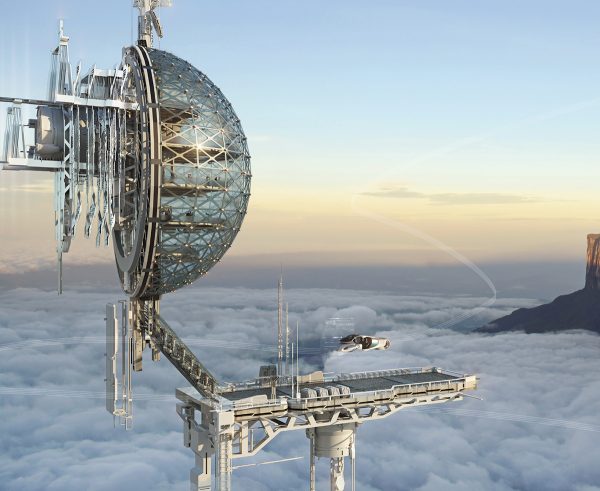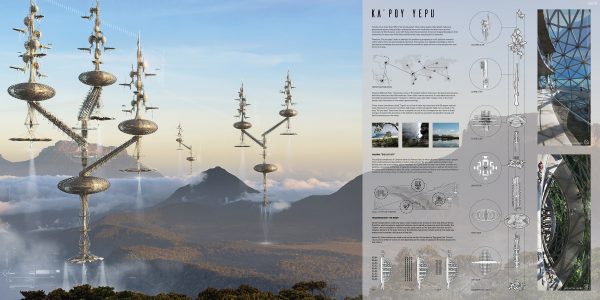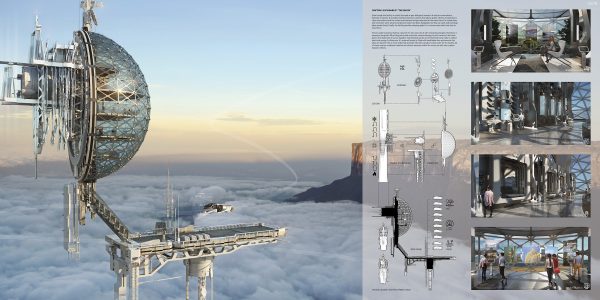Honorable Mention
2019 Skyscraper Competition
Zöe Russián Moreno
Venezuela
OUTLINE | PURPOSE
Forests cover more than 30% of the entire planet. They create oxygen, they absorb malicious greenhouse gasses, they provide a substantial source of medicines, and many more actives necessary for life. However, even with these vital characteristics, it has not stopped developers from exhausting its resources while being misinformed; never reaching its full potential. Therefore, “Ka’ poy yepü” seeks to address this problem by proposing a multi-platform research center with a focus on geo-biological education. The purpose is to expand knowledge on how to harmonize technology and nature by networking around the globe on how to use and discover new forms of energy.
ORIGINS | DESIGN
Canaima National Park – Venezuela, is one of the largest natural reserves on the planet and possess definitive characters that differentiates it from other natural reservoirs. It’s soil dates back to the precambrian period, between 1.5 million to 2 billions years old; which makes it one of the most ancient rock formations in the world’s geochronology. These unique formations called “Tepuis” are a kind of table-top mountains with 90 degree vertical walls. Because of its ancient condition, high levels of electromagnetic fields can be found in the area. “Ka’ poy yepü” uses these forces to expand the use of electromagnetism as a form of direct energy. It prevents the disruption of the habitat by harboring said electromagnetism to keep the facility hovering over the valley.
PHILOSOPHY
The original inhabitants of Canaima were the Pemon tribe, for whom the word pemon means ‘people’. Their relationships and perception of nature inspired how “Ka’ poy yepü” seeks and stores data. Named after the locals dialect, which translates to “I come from the sky, from infinity” provides the facility a connection to the land. It expands throughout several structures in additive formation over the valley while scanning for data. By using a combination of Mixed-Reality and Augmented-Reality it creates a non-invasive mean to educate visitors and researchers alike.
FORMATION | TRANSPORTATION
Aerial transportation is the only way to reach Canaima due to lack of roads and difficult terrain. Therefore, electromagnetic enhanced vehicles were created as means to reach the facility. The “Töröns”, which translates to ‘Birds’ have the same matrix as “Ka’ poy yepü” and work as links between all parts of the main structure. The vehicles can access remote areas in the valley and makes sure to provide a full picture of the site. Above all, these vehicles are used as structure carriers for the facility. They guide the ‘Cocoon’ structures to different towers on site depending on the needs of expansion from both researches and visitors.
FUNCTION | FOOTPRINT
Even though the facility is mostly focused on geo-biological research it does accommodate a diversity of visitors. It includes several interactive centers that allows public citizens to experience close encounters with the unique environment and get educated at the same time. For researchers and scientists; semi-private and private areas have been designated so they can work and exchange ideas productively. Finally, the facility provides sleeping pods for in-house researches that stay for long terms.
SUSTAINABILITY
“Ka’ poy yepü” presents itself as a pioneer for new sources of self-sustaining energies. Therefore, it proposes using both 3D printing joints and molecular nanotechnology to self-construct the mesh pieces that holds the structure together. Gravitational panels are infused with solar cells to collect electrical energy. Furthermore, It’s external facade is filled with breathable skin and sensors that allow for liquid in the air to be collected and later filtered to produce clean water for the facility. All of these sources combined maintain an intrinsic harmony within the structure with zero-carbon footprint effects.

















